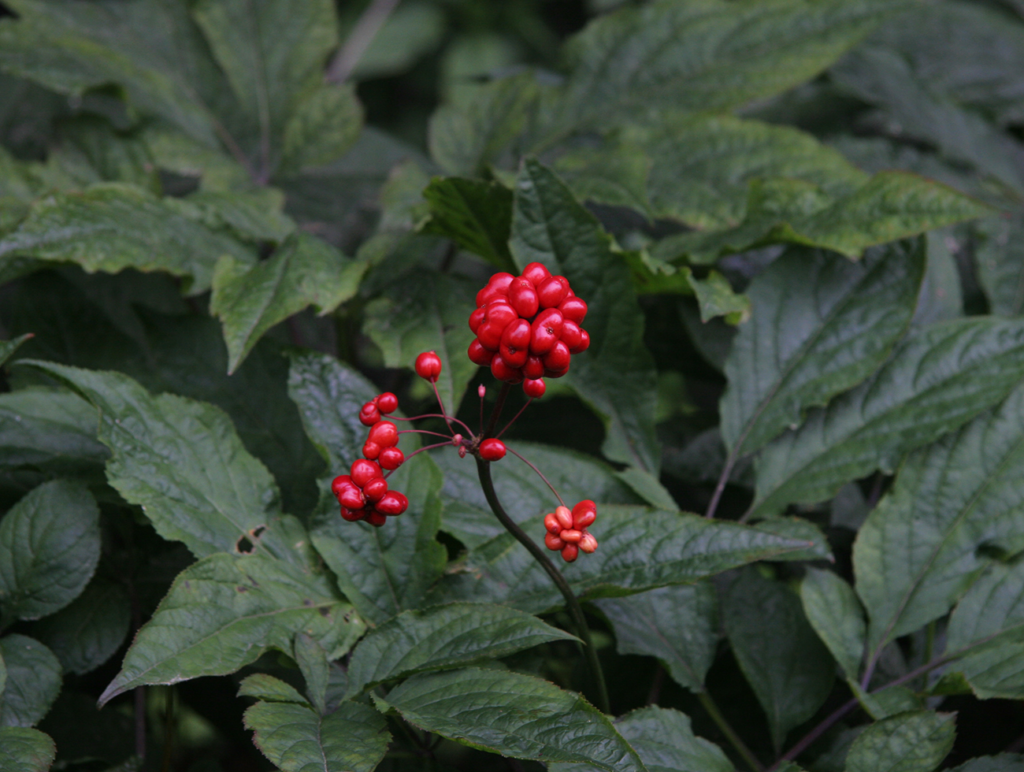①

▲ photo : the ripe Berry of Ginseng[Insam]
© The Academy of Korean Studies · Yu Namhae
It is a drupe with two semicircular nuclei[a fruit with one or several hard nuclei in the middle], and ripens in red.
▲ 사진 : 인삼(人蔘)의 열매가 익은 모습
© 한국학중앙연구원·유남해
반원형의 핵 2개가 있는 핵과[核果 : 가운데에 하나 혹은 여러 개의 단단한 핵이 있는 열매]로, 붉은색으로 익는다.
<1 of 5p>
②
▲ photo : Various colors of Ginseng[Insam] Berries
© Rural Development Administration
Ginseng[Insam] Berry is divided into seed, seed coat, pulp, and fruit skin. It blooms in mid-May and bears fruit, matures in mid-July and is harvested in late July, so the period in which red ripe berries can be seen in Ginseng[Insam] Fields is very short, about 10 days.
▲ 사진 : 인삼(人蔘) 열매의 다양한 색깔
© 농촌진흥청
인삼 열매는 종자(種子), 종피(種皮), 과육(果肉) 및 과피(果皮)로 구분되는데, 5월 중순경에 개화해 열매가 맺히고 7월 중순에 열매가 성숙해 7월 하순경에 수확(收穫)을 하기 때문에 인삼밭에서 빨갛게 익은 열매를 볼 수 있는 기간은 열흘 정도로 매우 짧다.
<2 of 5p>
③
▲ photo : Harvested Ginseng[Insam] Berries
© Rural Development Administration
※ Ginseng[Insam] : The Berry of Ginseng[Insam] contains as much Saponin[Ginsenoside) as the root, but unfortunately, it is not properly utilized yet.
▲사진 : 수확(收穫)을 거둔 인삼(人蔘) 열매
© 농촌진흥청
※ 인삼(人蔘) 열매 : 인삼의 열매도 뿌리에 못지 않게 사포닌(진세노사이드)이 많지만, 안타깝게도 아직은 제대로 활용되지 못하고 있다.
<3 of 5p>
④
Ginseng[Insam] Berry is known to help improve wrinkles and maintain skin elasticity, so it has been widely used as a tea along with ginseng leaves.
According to a Study conducted by the Korean Ginseng[Insam] Division of Rural Development Administration, the Saponin content of Ginseng Berry peel was higher than that of the root. In particular, Ginsenoside Re, which is effective in antidiabetic and liver function improvement, is known to be two to six times higher than the root.
Therefore, if Insam[Ginseng] Berry is used as Functional products such as tea, beverage, and cosmetics, it can become a new source of income for farmers.
Currently, Researches on diabetes, obesity prevention, anti-aging, and longevity effects and Efficacies of Ginseng Berry are being actively conducted in Korea, the United States, the United Kingdom, and Japan etc.
* Source: Rural Development Administration press release (2013.07)
※ Ginsenoside Re is a protopanaxatriol-type Saponin extracted from the berry, leaf, stem, flower bud, and root of Panax Ginseng.
* Source: National Library of Medicine
<4 of 5p>
④-K
🇰🇷 [Korean Version 한글판]
인삼(人蔘) 열매는 주름 개선, 피부(皮膚) 탄력을 유지하는데 도움을 주는 것으로 알려져 있어 인삼 잎과 함께 차(茶)로 널리 이용되어 왔다.
농촌진흥청(農村振興廳) 인삼과(人蔘課)의 연구(硏究)에 따르면, 인삼 열매 껍질의 사포닌 함량은 뿌리보다 높은 것으로 나타났다. 특히 항당뇨(抗糖尿), 간(肝) 기능 개선 등에 효능이 있는 진세노사이드 Re 성분은 뿌리보다 2-6배 더 높은 것으로 알려졌다.
따라서 인삼(人蔘) 열매를 차(茶)나 음료(飮料), 화장품(化粧品) 등 기능성 제품 등으로 활용한다면 농가(農家)의 새로운 소득원(所得源)이 될 수 있다.
현재 인삼(人蔘) 열매의 당뇨(糖尿)나 비만(肥滿) 예방, 노화(老化) 방지 및 장수(長壽) 효과 그리고 효능(效能) 등에 대한 연구는 한국, 미국, 영국, 일본 등에서 활발하게 진행되고 있다.
* 출처 : 농촌진흥청 보도자료 (2013.07)
※ Ginsenoside Re 는 인삼(人蔘)의 열매, 잎, 줄기, 꽃봉오리, 뿌리에서 추출한 ‘프록토파낙사 트리올계 사포닌( protopanaxatriol-type saponin)’ 입니다.
* 출처 : 미국 국립의학도서관
<4-K of 5p>
⑤
•These statements have not been evaluated by the Ministry of Food and Drug Safety.
•This product is not intended to diagnose, treat, cure or prevent any disease.
• 위 설명은 식품의약품안전처의 평가를 받지 않았습니다.
• 이 제품은 질병을 진단, 치료, 치유 또는 예방하기 위한 것이 아닙니다.
글 : ‘빨간 인삼’ 편집부
the latest
- ‘Ginseng’ is called “INSAM(인삼 人蔘)” in south & north Korea.
- ‘Five Support of Red Insam[Ginseng]’ in modern medicine 홍삼(紅蔘)의 다섯 도움(支援) 외
- Ginseng[Insam] in Oriental classics 동양고전(東洋古典)속의 인삼(人蔘)
- Types of Ginseng[Insam] 인삼(人蔘)의 종류(種類)
- About : “RedINSAM.com™”


https://www.instagram.com/koreanginseng
<5 of 5p>
COPYRIGHT © 2023 Red Insam.com™. All rights reserved.